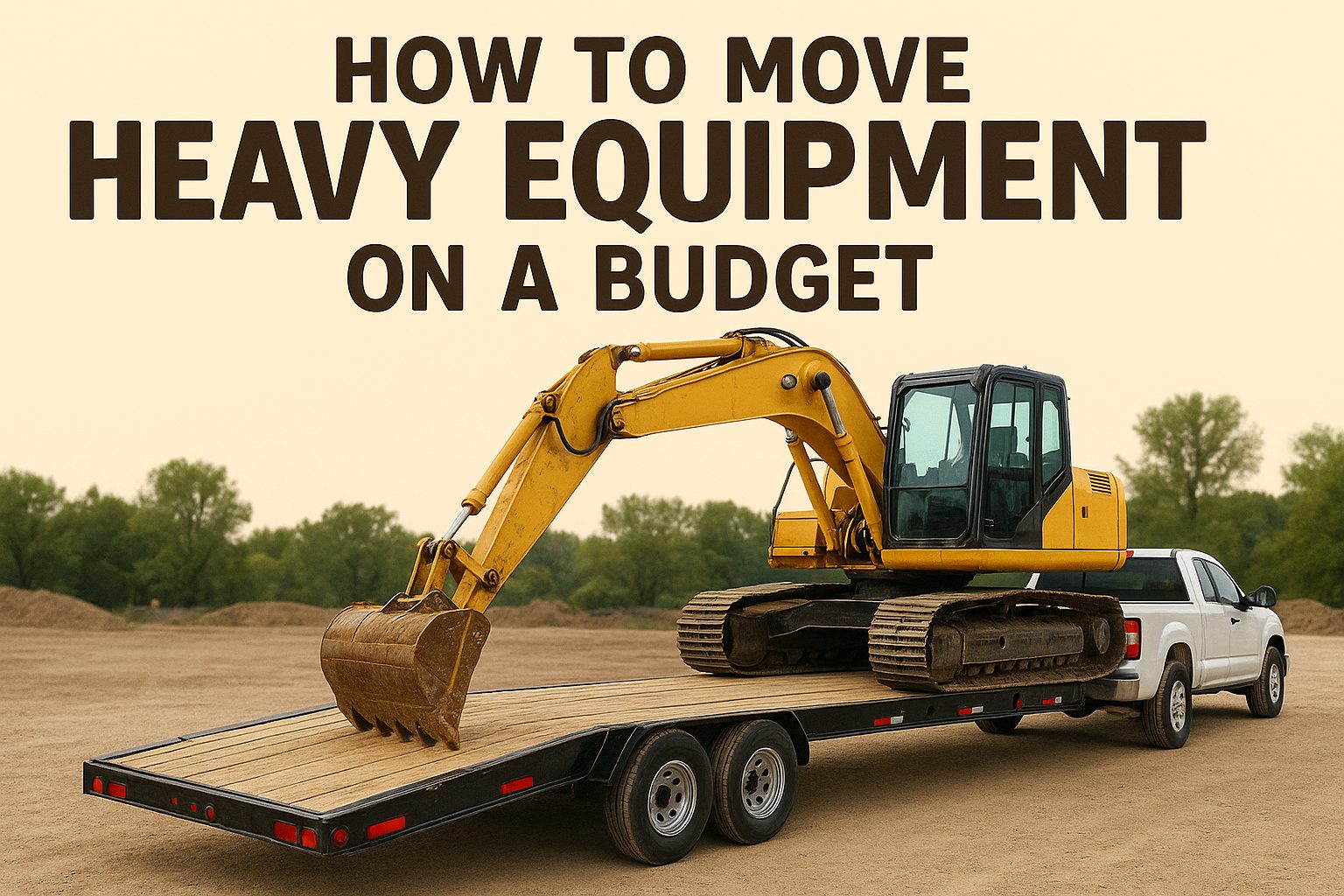Transferring big machines can be a tedious exercise, breaking the bank. Whether it is moving a bulldozer, excavator, or any heavy machinery on an industrial scale, knowing how to move heavy equipment efficiently and reasonably is paramount to business operators, construction supervisors, and farmers in general. With careful planning, adequate resources, and insiders’ know-how, you could transfer safely, efficiently, even if you’re on a tight budget.
When arranging any relocation project, particularly for construction or industrial equipment, it’s important to look for services such as heavy haul trucking to provide adequate handling and transportation.
Why Efficient Planning Matters
One of the biggest reasons budgets get out of hand on equipment moves is poor planning. To prevent expensive errors:
- Gauge the size and weight of equipment.
- Consider destination access (road width, grade, etc.).
- Consider the route and whether there are required permits.
- Select a proper trailer or rigging system.
Neglecting these factors when trying to understand how to move heavy equipment can lead to surprise bills, harm to your equipment, or even legal repercussions.
A Budget-Friendly Move in Action
A Texas-based small construction company wanted to move a 15-ton excavator 120 miles away last year. Instead of using a moving service, they:
- Rented a lowboy trailer.
- Hired a local operator to load/unload.
- Handled their permits.
By organizing these elements separately, they managed to save more than $1,500 without sacrificing safety. This is one of the best examples of moving heavy equipment economically through research and initiative.
How to Move Heavy Equipment with Budget-Friendly Methods
Here are proven strategies to help you move heavy equipment without overspending.
- Rent Instead of Buy
- Renting flatbeds or lowboys is much less expensive than buying.
- Many equipment rental companies commonly offer day rates or weekly rates.
- Other equipment, such as rollers and skates, can also be leased inexpensively.
- Use Skilled Labor Selectively
- It is sometimes unavoidable to hire a heavy equipment mover for heavy equipment transportation, but certainly not for everything.
- Reserve professional assistance for key operations such as loading or rigging.
- Use your staff for disassembling, securing, and simple handling.
- Schedule Off-Peak Transportation
- Steer clear of peak-demand seasons when prices are soaring (spring and end of summer).
- Weekday and mid-month moves will be less expensive.
- Early reservations can secure improved prices.
- Share Transport with Others
- Consider sharing the cost with nearby companies relocating equipment to the same location.
- Transport consolidators or co-loading services are a little-known budget trick.
- Ask rental firms or brokers if they have shared loads available.
- Leverage Local Connections
- Farmers, construction crews, or municipalities might have the right equipment to help move heavy objects.
- Ask around, borrowing equipment or trailers can cut costs.
- Local logistics companies that service small areas may provide off-hour discounted rates.
Cost-Saving Tips vs. Full-Service Moves
| Task | DIY / Budget Method | Full-Service Approach |
| Trailer | Rent locally | Provided by the moving company |
| Permits | File yourself via the state DOT | Handled by the company |
| Loading Equipment | Use your crew + rented crane | Company labor + rigging included |
| Insurance | Purchase short-term cargo insurance | Included in the premium |
| Coordination | Self-managed | Fully coordinated |
Important Tools for Budget Equipment Moving
When learning how to move heavy equipment, having the right tools can change the game in the following ways:
- Skates and rollers: Suitable for factory relocations.
- Forklifts or cranes: Renting is possible.
- Ratchet chains and straps: Hold equipment during transportation.
- Hydraulic jacks: Contribute to equipment lifting safely.
- Safety gear: Helmets, gloves, steel-toed boots.
If you’re not sure about the tools to use, check with a local rental store or an experienced mover for guidance. Even a phone call will help prevent incorrect equipment rental and forgetting an important safety item. The goal is not merely to save cash but to protect yourself from harm and prevent damage during transit.
Safety Considerations in Learning How to Move Heavy Equipment
Even when keeping an eye on your wallet, never compromise on safety. Make sure you:
- Make pre-move inspections.
- Mark machine components for reassembly.
- Utilize spotters during loading/unloading.
- Monitor weather conditions along the travel route.
- Verify all safety certifications are current.
- Examine local and federal transport regulations.
A bit of effort goes a long way. Investing the extra effort in safety checks can prevent catastrophic outcomes and keep your move on track.
Mid-Move Considerations
After the trip is underway, route monitoring and tracking become essential. Some companies offer live tracking, but it is also possible to use GPS units or mobile phone programs. This is a good idea in any heavy equipment transport plan, particularly if your trip has multiple stops or city navigation.
Also, stock up for roadside emergencies. Pack:
- A standard mechanic toolset.
- Flashlights and high-visibility vests.
- Additional ratchet straps and chain binders.
- First-aid kit and emergency contact information.
Additionally, prepare your driver or transportation partner by providing them with a complete briefing on the equipment. Provide them with maintenance advice, loading procedures, and potential steps for troubleshooting. A bit of extra preparation will save time and avoid expensive roadside mishaps.
Professional Services Worth Considering
At times, it’s worth paying for expertise to save costs in the long term. For example:
- Construction equipment hauling services are specialized in hauling sophisticated, oversized machinery and can be competitive for certain projects.
These businesses have a lot of experience and specialized gear, so they’re a better bet for tough hauls. By packaging your needs into a single service, you can negotiate package deals or long-term contracts.
If you’re moving multiple assets, packaging them into one trip with a pro might still be cheaper than a series of DIY moves.
How to Move Heavy Equipment and Reduce the Cost?
The cost to move heavy equipment depends on distance, size, permits, and handling complexity. Nevertheless, with the advice above, you can significantly reduce those costs. Strategically plan, consolidate resources, and get the right assistance.
- More Ways to Save
- Utilize load boards or transport marketplaces.
- Do not accept unnecessary insurance upgrades.
- Pickup and deliver between flexible times to skip surcharges.
- Consolidate several pieces of equipment into a single move.
- Make offers for reverse logistics by companies for returning empty trailers.
- Search for grants or tax credits that help defray transport expenses.
Little details matter. Even small tweaks to your loading process, equipment preparation, or scheduling can translate into significant savings in the long run. These micro but deliberate strategies all contribute, making your operation lean and efficient.
Luxury car transportation services, though not your immediate guess, frequently utilize enclosed trailers that can easily be repurposed for light equipment or delicate gear.
Knowing how to move heavy equipment effectively makes you capable of preventing costly services and delays.
Your Smart Move Starts with a Plan
Whether you’re a small company or a big contractor, it’s all about planning, local expertise, and wise outsourcing to transport heavy equipment affordably. You don’t have to break the bank, you just need the proper plan.
Consider contacting experienced partners or seeking advice from transport experts like Specialty Hauling SVCS when beginning planning. The better informed you are, the more smoothly your operation will proceed.
Ready to make your next equipment move hassle-free and budget-friendly? Reach out to the specialists today via phone at 912-803-8356 or send an email to [email protected] for expert guidance or a specialized moving solution that meets your requirements!
Frequently Asked Questions
How to move heavy equipment safely?
Utilize proper rigging equipment, tie down equipment with straps or chains, and always have competent spotters present.
Can I move heavy equipment without a permit?
Certain states have a permit requirement for oversized loads. Always check with the state Department of Transportation.
What equipment is best for loading heavy machinery?
Forklifts, cranes, and hydraulic jacks are mostly used.
How long does it take to move large equipment?
It depends on distance and logistics and could take from a few hours to several days.
Is it possible to learn how to move heavy equipment as a beginner?
Yes, safety procedures, proper training, and guidance can even teach beginners how to relocate heavy equipment safely.





